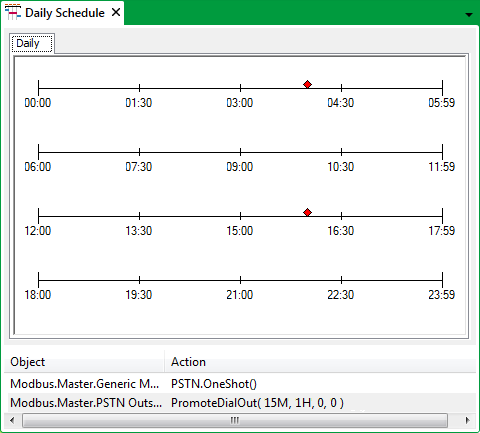You can use Schedules to perform specific functions on your system at regular, specified times. For example:
- Generate reports
- Archive data
- Run logic programs
- Dial out to PSTN outstations.
You can choose the type of Schedule that you require in relation to the frequency of the events that you want to schedule on your system—Simple, Daily, Weekly, Monthly, or Yearly (see Types of Schedule Display).
Schedules allow you to automate regular functions, to alleviate the need for manual intervention each time such a function needs to be carried out (see Set up a Schedule).
Example:
The figure below shows a Schedule in which events are triggered at 04:05 and 16:05 on a daily basis.
The actions that the Schedule triggers at those times are a one shot call to an outstation (Master.Generic.PSTN Outstation), and a dial out promotion to an outstation set (Master.PSTN Outstation Set).
The promotion period, enclosed in parentheses, shows that the promotion is for a 15-minute interval over a one-hour period. The first 0 indicates that the server does not dial the outstations on the set as soon as the promotion period starts. The second 0 indicates the synchronization offset from the scheduled times (as this is zero, the server starts the promotion period at the event times specified on Schedule, rather than at an offset from those times).

Scheduled events are triggered infinitely at the times and regularity indicated on the Schedule Display (Daily, Weekly, Monthly, and Yearly Schedules), or on the Schedule Form (Simple Schedules). To halt a Schedule you need to take it out of service.
Further Information